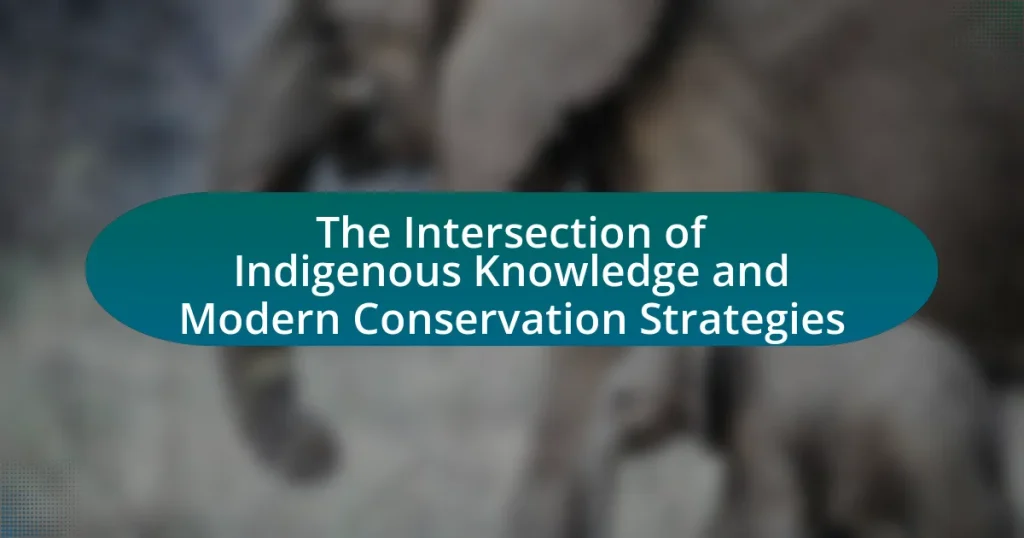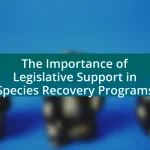The article examines the intersection of Indigenous knowledge and modern conservation strategies, highlighting the integration of traditional ecological practices with contemporary scientific approaches to biodiversity preservation. It outlines the differences between Indigenous knowledge, which is rooted in cultural practices and community-based management, and modern conservation strategies that often rely on scientific data and regulatory frameworks. Key principles of Indigenous knowledge, such as a deep connection to the land and holistic ecosystem understanding, are discussed alongside foundational elements of modern conservation, including biodiversity preservation and community engagement. The article emphasizes the importance of integrating Indigenous perspectives to enhance conservation outcomes, while also addressing the challenges and barriers to collaboration between Indigenous communities and conservation organizations. Successful examples of this integration are presented, along with practical steps for fostering collaboration and supporting Indigenous-led conservation efforts.
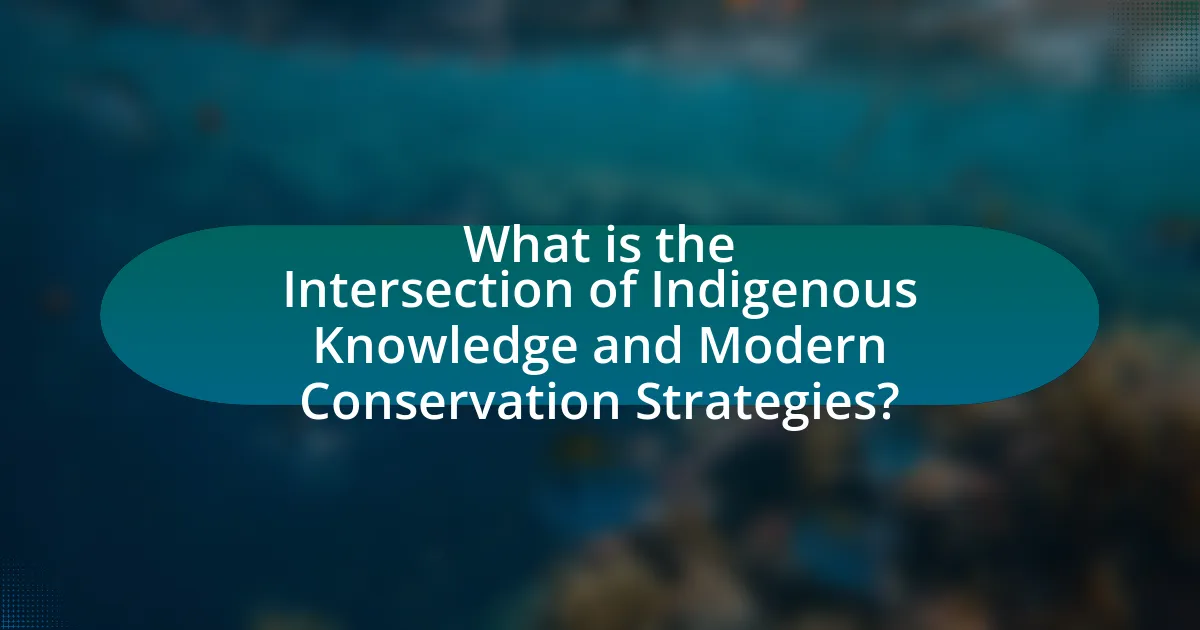
What is the Intersection of Indigenous Knowledge and Modern Conservation Strategies?
The intersection of Indigenous knowledge and modern conservation strategies lies in the integration of traditional ecological practices with contemporary scientific approaches to biodiversity preservation. Indigenous communities possess a deep understanding of local ecosystems, developed over generations, which can enhance modern conservation efforts by providing insights into sustainable land management, species behavior, and ecosystem resilience. For example, the use of fire management techniques by Indigenous peoples has been shown to reduce wildfire risks and promote biodiversity, as evidenced by studies such as those published in the journal “Ecological Applications,” which highlight the effectiveness of Indigenous practices in maintaining healthy landscapes. This collaboration fosters a holistic approach to conservation that respects cultural heritage while addressing environmental challenges.
How do Indigenous Knowledge and Modern Conservation Strategies differ?
Indigenous Knowledge and Modern Conservation Strategies differ primarily in their approaches to environmental stewardship. Indigenous Knowledge is rooted in centuries of cultural practices, oral traditions, and a deep spiritual connection to the land, emphasizing holistic and community-based management. In contrast, Modern Conservation Strategies often rely on scientific research, technological interventions, and regulatory frameworks, focusing on biodiversity preservation through structured methodologies.
For example, Indigenous communities may utilize traditional ecological knowledge to manage resources sustainably, as seen in the practices of the Māori in New Zealand, who have successfully maintained fish populations through customary fishing regulations. Conversely, Modern Conservation Strategies, such as the establishment of protected areas, often prioritize quantitative assessments and data-driven policies, which can sometimes overlook local ecological knowledge and community involvement. This distinction highlights the need for integrating both approaches to enhance conservation outcomes.
What are the key principles of Indigenous Knowledge?
The key principles of Indigenous Knowledge include a deep connection to the land, holistic understanding of ecosystems, community-based practices, and the integration of cultural values. Indigenous Knowledge emphasizes the relationship between people and their environment, recognizing that ecological systems are interconnected and that human well-being is tied to the health of these systems. This knowledge is often passed down through generations, reflecting a long history of observation and adaptation to local conditions. For example, Indigenous practices in fire management have been shown to enhance biodiversity and reduce the risk of large wildfires, demonstrating the effectiveness of traditional ecological knowledge in contemporary conservation efforts.
What are the foundational elements of Modern Conservation Strategies?
The foundational elements of Modern Conservation Strategies include biodiversity preservation, sustainable resource management, community engagement, and the integration of traditional ecological knowledge. Biodiversity preservation focuses on protecting various species and their habitats to maintain ecosystem balance. Sustainable resource management emphasizes the responsible use of natural resources to ensure their availability for future generations. Community engagement involves local populations in conservation efforts, recognizing their role and knowledge in protecting the environment. The integration of traditional ecological knowledge acknowledges the value of indigenous practices and insights, which can enhance conservation outcomes. These elements collectively contribute to effective and holistic conservation approaches.
Why is the integration of Indigenous Knowledge important for conservation?
The integration of Indigenous Knowledge is important for conservation because it provides valuable insights into sustainable practices and ecosystem management that have been developed over generations. Indigenous communities possess a deep understanding of local biodiversity, ecological relationships, and land stewardship, which can enhance modern conservation strategies. For example, studies have shown that areas managed by Indigenous peoples often exhibit higher biodiversity and resilience to climate change compared to those managed by conventional methods. This is evidenced by research conducted by the United Nations Environment Programme, which highlights that Indigenous territories cover about 22% of the Earth’s land surface and contain 80% of the world’s remaining biodiversity. Therefore, incorporating Indigenous Knowledge into conservation efforts not only respects cultural heritage but also improves ecological outcomes.
How does Indigenous Knowledge enhance biodiversity conservation?
Indigenous Knowledge enhances biodiversity conservation by integrating traditional ecological practices with contemporary conservation methods. This knowledge, accumulated over generations, includes insights into local ecosystems, species behavior, and sustainable resource management. For instance, Indigenous communities often employ rotational farming and controlled burns, which promote habitat diversity and prevent wildfires, thereby supporting various species. Research indicates that areas managed by Indigenous peoples often exhibit higher biodiversity levels compared to those under conventional management, as seen in studies conducted in the Amazon rainforest, where Indigenous territories maintain greater ecological integrity.
What role does cultural heritage play in conservation efforts?
Cultural heritage plays a crucial role in conservation efforts by providing a framework for understanding the relationship between communities and their environment. This relationship is essential for developing effective conservation strategies that respect local traditions and knowledge. For instance, Indigenous practices often include sustainable land management techniques that have been honed over generations, which can enhance biodiversity and ecosystem resilience. Research indicates that integrating Indigenous knowledge into conservation planning can lead to more successful outcomes, as seen in projects like the Great Bear Rainforest in Canada, where Indigenous stewardship has been pivotal in preserving ecological integrity.
What challenges exist at the intersection of Indigenous Knowledge and Modern Conservation Strategies?
Challenges at the intersection of Indigenous Knowledge and Modern Conservation Strategies include differing worldviews, communication barriers, and power imbalances. Indigenous Knowledge often emphasizes holistic, place-based approaches that prioritize community and cultural values, while modern conservation strategies may focus on scientific data and standardized practices. This divergence can lead to misunderstandings and conflicts over land use and resource management. Additionally, communication barriers arise from differences in language and cultural context, making collaboration difficult. Power imbalances further complicate these interactions, as Indigenous communities may lack representation in decision-making processes, undermining their rights and knowledge systems. These challenges hinder effective conservation efforts that could benefit from integrating Indigenous perspectives.
How do differing worldviews impact conservation practices?
Differing worldviews significantly impact conservation practices by shaping the values, priorities, and methods employed in environmental stewardship. For instance, Indigenous worldviews often emphasize a deep spiritual connection to the land, leading to conservation strategies that prioritize biodiversity and ecosystem health, as seen in practices like rotational hunting and sustainable agriculture. In contrast, Western scientific perspectives may focus on quantifiable metrics and resource management, which can result in approaches such as habitat restoration and species reintroduction. Research by Berkes and Folke (1998) highlights that integrating Indigenous knowledge with modern conservation strategies can enhance ecological resilience and sustainability, demonstrating that the fusion of these differing worldviews can lead to more effective conservation outcomes.
What are the barriers to collaboration between Indigenous communities and conservation organizations?
Barriers to collaboration between Indigenous communities and conservation organizations include differing priorities, lack of trust, and inadequate representation. Indigenous communities often prioritize cultural preservation and land rights, while conservation organizations may focus on biodiversity and ecosystem services, leading to conflicting goals. Additionally, historical injustices and marginalization contribute to a lack of trust, making collaboration difficult. Furthermore, Indigenous voices are frequently underrepresented in decision-making processes, which can hinder effective partnerships. These factors create significant challenges in aligning the objectives of both parties for successful conservation efforts.
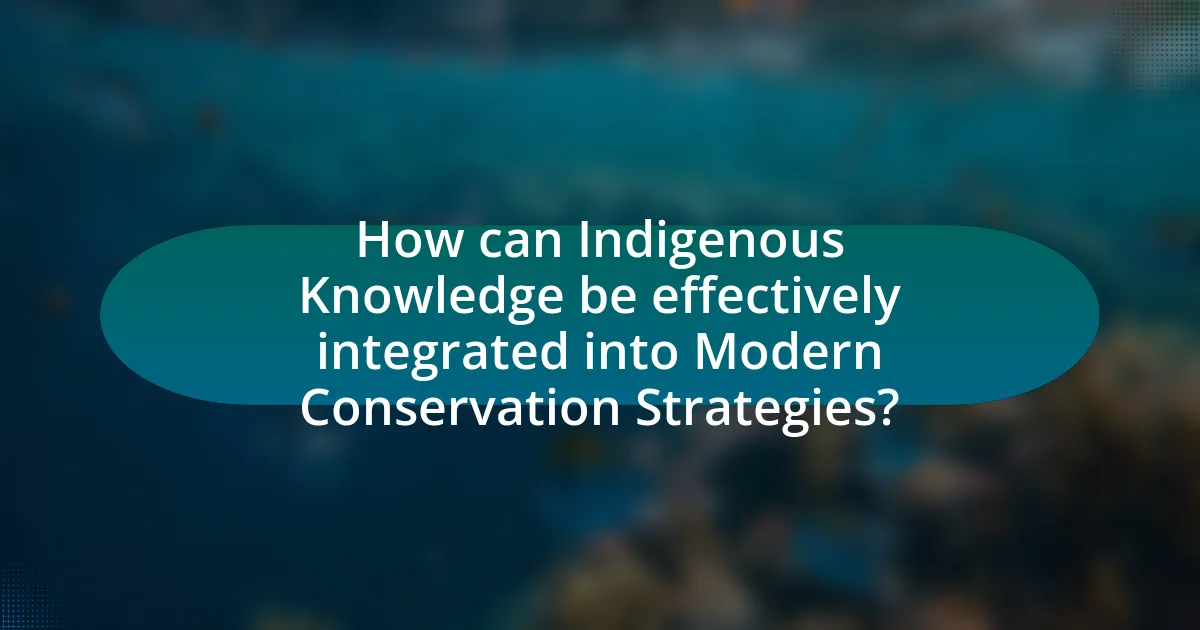
How can Indigenous Knowledge be effectively integrated into Modern Conservation Strategies?
Indigenous Knowledge can be effectively integrated into modern conservation strategies by recognizing and valuing the ecological insights and practices that Indigenous communities have developed over generations. This integration can occur through collaborative partnerships where Indigenous peoples are involved in decision-making processes, ensuring their traditional ecological knowledge informs conservation planning and management. For instance, the incorporation of Indigenous fire management practices has been shown to reduce wildfire risks and enhance biodiversity, as evidenced by studies in Australia where Indigenous land management techniques have led to healthier ecosystems. By formalizing these partnerships and respecting Indigenous rights, conservation strategies can become more holistic and effective, ultimately benefiting both biodiversity and Indigenous communities.
What successful examples exist of this integration?
Successful examples of integrating Indigenous knowledge with modern conservation strategies include the collaborative management of national parks in Australia, such as Kakadu National Park. In this case, Indigenous landowners work alongside government agencies to manage the park, utilizing traditional ecological knowledge to enhance biodiversity and ecosystem health. This partnership has led to improved fire management practices, which are informed by Indigenous burning techniques, resulting in reduced wildfire risks and increased habitat for native species. Additionally, the Maori-led conservation initiatives in New Zealand, such as the restoration of the Whanganui River, demonstrate effective integration by recognizing the river as a living entity and incorporating traditional stewardship practices into modern environmental management frameworks. These examples illustrate the effectiveness of combining Indigenous perspectives with contemporary conservation efforts to achieve sustainable outcomes.
How have Indigenous-led conservation initiatives succeeded?
Indigenous-led conservation initiatives have succeeded by effectively integrating traditional ecological knowledge with modern conservation practices, resulting in enhanced biodiversity and ecosystem resilience. For example, the Indigenous Guardians program in Canada has demonstrated success by employing local Indigenous knowledge to manage and protect over 1.5 million square kilometers of land and water, leading to improved wildlife populations and habitat restoration. Additionally, studies show that areas managed by Indigenous communities often experience lower rates of deforestation and higher biodiversity compared to non-Indigenous managed areas, highlighting the effectiveness of these initiatives in achieving conservation goals.
What lessons can be learned from case studies of successful integration?
Case studies of successful integration reveal that collaboration between Indigenous knowledge and modern conservation strategies enhances biodiversity and ecosystem resilience. For instance, the integration of traditional ecological knowledge (TEK) in land management practices has led to improved outcomes in areas such as fire management and species conservation. Research conducted by the United Nations Environment Programme highlights that Indigenous-led conservation initiatives often result in higher biodiversity levels compared to conventional methods, demonstrating the effectiveness of combining local knowledge with scientific approaches. This evidence underscores the importance of respecting and incorporating Indigenous perspectives in conservation efforts to achieve sustainable environmental outcomes.
What methods can be used to facilitate collaboration between Indigenous communities and conservationists?
To facilitate collaboration between Indigenous communities and conservationists, methods such as co-management agreements, participatory research, and the integration of traditional ecological knowledge into conservation practices can be employed. Co-management agreements allow both parties to share decision-making power and responsibilities, ensuring that Indigenous perspectives are respected and incorporated into conservation efforts. Participatory research involves Indigenous communities in the data collection and analysis processes, fostering trust and mutual understanding. Furthermore, integrating traditional ecological knowledge, which encompasses centuries of Indigenous understanding of local ecosystems, can enhance conservation strategies by providing insights that modern science may overlook. These methods have been shown to improve conservation outcomes and promote sustainable practices that benefit both Indigenous communities and biodiversity.
How can mutual respect and understanding be fostered?
Mutual respect and understanding can be fostered through active listening and open dialogue between diverse cultural groups. Engaging in conversations that prioritize the perspectives and values of Indigenous communities alongside modern conservation strategies promotes collaboration. Research indicates that integrating Indigenous knowledge into conservation efforts leads to more effective environmental management, as seen in studies like “Indigenous Knowledge and Conservation” by Berkes et al., which highlights the success of co-management approaches in various ecosystems. This collaborative framework not only respects Indigenous traditions but also enhances the overall effectiveness of conservation initiatives.
What role does education play in bridging gaps between communities?
Education plays a crucial role in bridging gaps between communities by fostering understanding and collaboration. It facilitates the exchange of knowledge, particularly in contexts where indigenous knowledge intersects with modern conservation strategies, promoting respect for diverse perspectives. For instance, educational programs that integrate indigenous practices with scientific approaches can enhance community engagement in conservation efforts, leading to more effective and culturally relevant outcomes. Research shows that when communities participate in educational initiatives that value their traditional knowledge, it strengthens social cohesion and empowers individuals, ultimately reducing disparities and fostering unity.
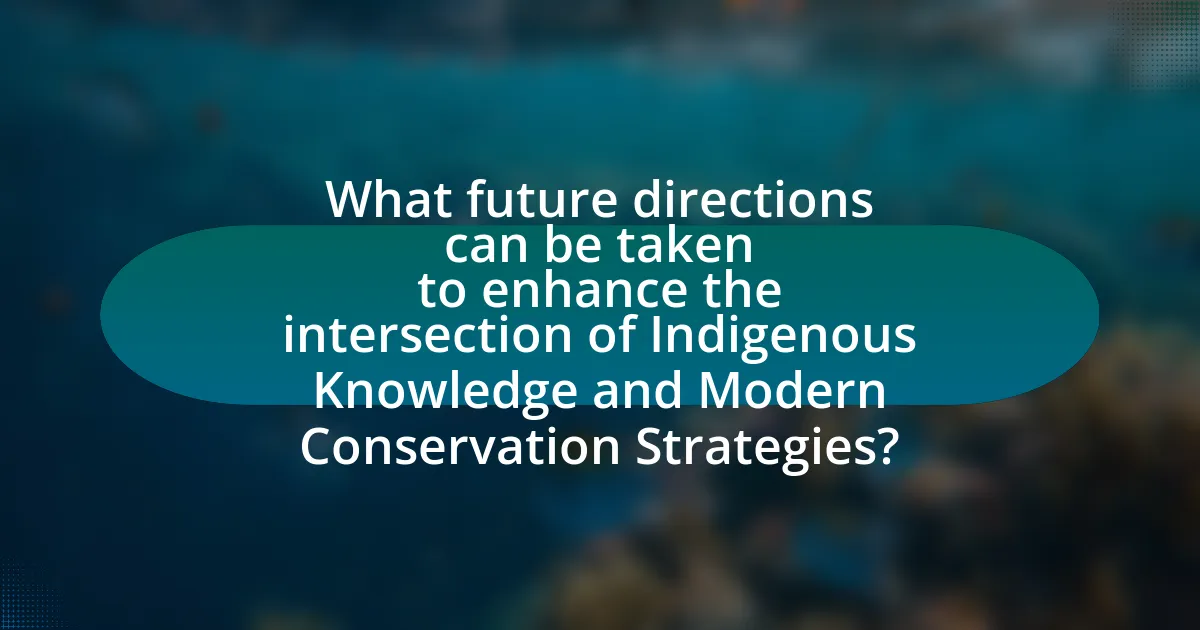
What future directions can be taken to enhance the intersection of Indigenous Knowledge and Modern Conservation Strategies?
Future directions to enhance the intersection of Indigenous Knowledge and Modern Conservation Strategies include integrating Indigenous practices into policy frameworks and fostering collaborative management approaches. Collaborative management, as seen in the co-management of natural resources in Canada, demonstrates the effectiveness of combining traditional ecological knowledge with scientific methods, leading to improved biodiversity outcomes. Additionally, educational programs that promote Indigenous perspectives in conservation can empower local communities and ensure sustainable practices are maintained. Research indicates that areas managed with Indigenous involvement often show higher ecological resilience, highlighting the importance of these strategies in modern conservation efforts.
How can policy changes support this intersection?
Policy changes can support the intersection of Indigenous knowledge and modern conservation strategies by formally recognizing and integrating Indigenous practices into environmental management frameworks. This integration can enhance biodiversity conservation efforts, as Indigenous communities often possess valuable ecological knowledge accumulated over generations. For instance, the United Nations Declaration on the Rights of Indigenous Peoples emphasizes the importance of Indigenous participation in decision-making processes related to land and resource management, which can lead to more effective conservation outcomes. Additionally, studies have shown that areas managed by Indigenous peoples often exhibit higher levels of biodiversity, demonstrating the effectiveness of their traditional ecological knowledge in sustaining ecosystems.
What specific policies can promote Indigenous participation in conservation?
Specific policies that can promote Indigenous participation in conservation include co-management agreements, legal recognition of Indigenous land rights, and funding for Indigenous-led conservation initiatives. Co-management agreements empower Indigenous communities by allowing them to share decision-making authority over natural resources, which has been shown to enhance biodiversity outcomes. Legal recognition of Indigenous land rights ensures that Indigenous peoples have control over their ancestral lands, leading to more effective stewardship practices. Additionally, providing funding for Indigenous-led conservation initiatives supports the integration of traditional ecological knowledge with modern conservation strategies, fostering sustainable practices that benefit both the environment and Indigenous communities.
How can funding be directed to support Indigenous-led conservation efforts?
Funding can be directed to support Indigenous-led conservation efforts by establishing dedicated grant programs that prioritize projects led by Indigenous communities. These programs can be designed to ensure that financial resources are allocated based on the specific needs and knowledge of Indigenous peoples, thereby enhancing the effectiveness of conservation initiatives. For instance, the Indigenous Guardians program in Canada provides funding to Indigenous groups to manage their traditional lands, demonstrating a successful model where funding is directly linked to Indigenous leadership and stewardship. This approach not only empowers Indigenous communities but also leverages their traditional ecological knowledge, which is crucial for effective conservation strategies.
What practical steps can individuals and organizations take to support this integration?
Individuals and organizations can support the integration of Indigenous knowledge and modern conservation strategies by actively collaborating with Indigenous communities in decision-making processes. This collaboration can include co-developing conservation plans that respect traditional ecological knowledge, which has been shown to enhance biodiversity outcomes. For instance, research published in the journal “Nature” highlights that Indigenous-managed lands often exhibit higher biodiversity levels compared to conventionally managed areas. Additionally, organizations can provide funding and resources for Indigenous-led conservation initiatives, ensuring that these communities have the necessary support to implement their traditional practices effectively. Engaging in cultural competency training for staff and stakeholders can also foster mutual respect and understanding, facilitating better partnerships.
How can awareness and advocacy be raised for Indigenous rights in conservation?
Awareness and advocacy for Indigenous rights in conservation can be raised through education, collaboration, and policy reform. Educational initiatives that highlight the importance of Indigenous knowledge in conservation practices can foster understanding and respect for Indigenous rights. Collaborative projects between Indigenous communities and conservation organizations can demonstrate the effectiveness of integrating traditional ecological knowledge with modern conservation strategies. Additionally, advocating for policy reforms that recognize and protect Indigenous land rights is crucial; for instance, the United Nations Declaration on the Rights of Indigenous Peoples emphasizes the need for Indigenous participation in decision-making processes related to their lands and resources. These approaches collectively enhance visibility and support for Indigenous rights within the conservation sector.
What best practices should be followed for effective collaboration?
Effective collaboration requires clear communication, mutual respect, and shared goals among all participants. Establishing open lines of communication ensures that all voices are heard, which is crucial in contexts involving diverse perspectives, such as Indigenous knowledge and modern conservation strategies. Mutual respect fosters an environment where different cultural insights are valued, enhancing the collaborative process. Shared goals align the efforts of all parties, creating a unified direction that is essential for successful outcomes. Research indicates that collaborative projects that incorporate these best practices are more likely to achieve sustainable results, as evidenced by case studies in conservation efforts that successfully integrate Indigenous practices with contemporary methods.
